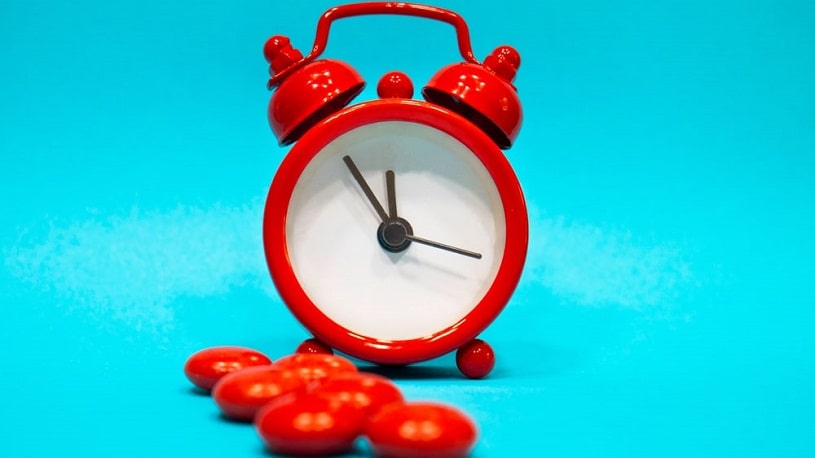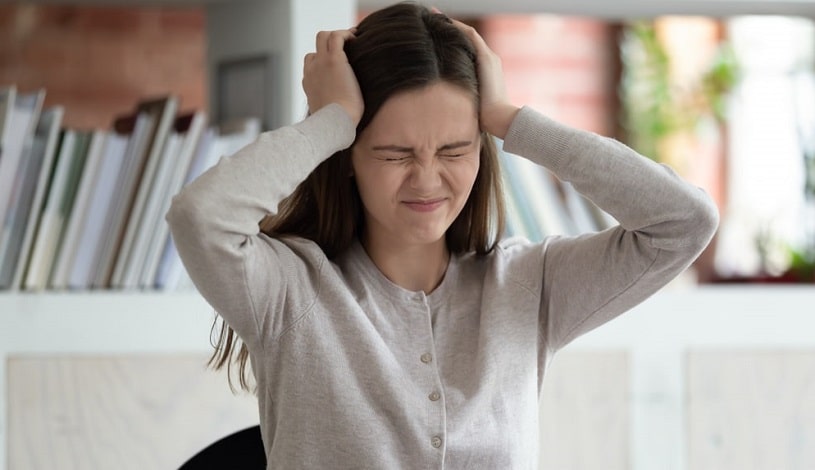As with any drug, Librium metabolites stay in the system for a certain period after the drug is stopped. The length of this period depends on several factors, such as Librium half-life.
Although with tapering the drug will remain in the system for longer, it’s the only way to discontinue the medication safely. Stopping Chlordiazepoxide cold turkey will lead to the onset of withdrawal symptoms, which can be severe.
Table Of Contents:
Read on to learn more about Librium half-life, withdrawal symptoms, and correct Librium taper.
Librium Half-Life
The Chlordiazepoxide half-life varies from 6.6 hours to 28 hours. It means that half of the ingested dose will be eliminated from the body during this timeframe. Such a wide window is caused by the fact that the rate at which the substance is removed from the system depends on many factors. After chronic high doses, for instance, the half-life can reach 48 hours.

The amount of substance in the bloodstream that provides no effects is 3.2% of the initial dose. It is reached after five half-lives or between 25 and 150 hours after ingestion, from one to six days. Some people, who have underlying health issues or take other drugs, will reach this level much slower.
Factors That Affect Detection Window
The time Librium lasts in one’s system and the detection window depend on several factors. It means that two people who have taken the same amount will process the drug differently.
Physiological Factors:
- Age and genetics – the older the patients are, the slower metabolism they have. It means that the substance will not be processed at an average level in elderly patients. That is because their kidneys will not manage to get rid of the substance from the body as fast as a younger patient. In an older patient, the drug will stay in their system longer, offering a longer window in case of a drug test.
- Overall health – if the patient suffers from certain health conditions, such as those affecting the liver or kidneys, the drug will be absorbed much slower.
- Body mass index – because fatty tissues highly absorb Chlordiazepoxide, overweight people will experience prolonged drug effects.
Not only personal physiological factors can affect the elimination. The method a patient used to take the drug also matters.
For Example:
- Quantity – the more chlordiazepoxide is used, the longer it will take to be processed, and the longer the effects will linger in the system. It is especially true in case abuse or addiction are present.
- Method – when administered intravenously, the substance will be absorbed and processed much faster. At the same time, the pill form will stay in the system the longest, therefore with an extended Librium half-life.
- Frequency – smaller amounts taken frequently are similar to larger amounts taken infrequently. It means that there will be more drug in the body if it is taken frequently, and it will take longer for the system to process it.
Other Drugs Taken
If the patient takes other drugs or alcohol while on Librium, this will affect the drug’s elimination time. It happens because chlordiazepoxide needs a certain enzyme that breaks it, and if other substances use this enzyme at the same time, the rate of drug clearance will be slowed down.
Using Librium with alcohol or other drugs is not a good idea, not only because it extends the elimination time. That’s because such combinations can lead to serious health effects and risks.
It is worth mentioning that some Chlordiazepoxide metabolites will take months to be eliminated from the body. For example, the desmethyldiazepam metabolite has a half-life, which varies from 36 to 200 hours.
How Long Does Librium Stay In Your System: Urine, Blood
Librium shows up on a drug test as a benzodiazepine. Although there is no specific test for chlordiazepoxide, the drug can show up on a standard 5-panel drug test. This test detects other benzodiazepines such as Valium, Xanax, Ativan, Halcion, Serax, Klonopin, and Rohypnol. Employers usually request such testing to check if their employees or job applicants take any prescription or OTC drug.
Blood Test
A blood test can detect the drug within 6 to 48 hours after the last ingestion. A blood test for this drug is not as common as other testing methods but might be required if Librium use is suspected.
Urine Test
In a routine urine test, Librium will show up as benzodiazepine. It stays in urine for up to 6 weeks since the last dose, mainly because chlordiazepoxide is excreted through urine.
Saliva Test
Requiring a saliva test for Librium is uncommon, but some agencies and employers might use it. The drug can be detected in saliva for up to 10 days.
Hair Test
A hair drug test has the most extended detection window, compared to blood, saliva, and urine tests, which only detect current or very recent use. Although an uncommon test, it might be used when chlordiazepoxide is not likely to be seen using other test methods. Hair tests can detect the substance for up to 90 days.
Librium Withdrawal
Librium withdrawal symptoms are noticeable after an abruptly lowering chlordiazepoxide dose or stopping the medication. These symptoms are more likely to happen to users who abuse Librium and have become dependent on it. People also may experience these symptoms by missing doses or switching to other benzodiazepines without a doctor’s recommendations.

The dose, frequency, duration of use, and a user’s overall health status and age also play a huge role in the development of chlordiazepoxide withdrawal symptoms.
Symptoms Of Withdrawal
As some withdrawal symptoms can be severe and even life-threatening, proper medical care and monitoring are required. One will start to feel unwell after the last dose, which is commonly referred to as a “comedown.” The symptoms will worsen and will hit a plateau before they start to disappear. Prolonged use of chlordiazepoxide will lead to more intense and lengthier symptoms. Users who had chlordiazepoxide for more than three weeks are expected to complain about the most common Librium withdrawal symptoms.
These Symptoms Include:
- Anxiety
- Agitation
- Abdominal cramps
- Increased heart rate
- High blood pressure
- Cravings
- Vomiting
- Depression
- Sweating
- Hallucinations
- Seizures
- Convulsions
- Tremors
Delirium tremens, when patients become confused and disoriented, are commonly observed among users of high doses for a long time. There are accompanying symptoms like anxiety, decreased attention span, and hallucinations.
Librium Withdrawal Timeline
Typically, the Librium withdrawal timeline is between 1 to 7 weeks, peaking during the 2nd and 3rd weeks. However, heavy users may end up struggling for months.
Week 1
Most users will start feeling restless or anxious within 24 hours after the last dose of chlordiazepoxide. For others, it takes at least a week before the onset of symptoms. Agitation, increased heart rate, loss of appetite, and sweating are common during this stage.
Weeks 2 To 3
During the next 2-3 weeks of Librium detox, the symptoms peak. One may start feeling more uncomfortable symptoms like stomach cramping, insomnia, nausea, dysphoria, and difficulty concentrating. In addition, heavy users may have hallucinations, tremors, psychosis, and seizures.
Weeks 4 To 6
During these weeks, most symptoms are manageable, with some already subsided. While there may still be anxiety, depression, and cravings, the intensity should be decreasing.
Week 7+
Most Librium withdrawal symptoms disappear at this stage, but patients may continue to experience cravings and some psychological symptoms. Anxiety may still suddenly reappear even after one has gone a long while free of any symptoms. It is known as protracted withdrawal, and it will only subside after abstinence for a long time.
Librium Taper
Stopping Chlordiazepoxide use abruptly is dangerous to health, posing numerous threats. It should be tapered off slowly during Librium detox. How to stop taking chlordiazepoxide depends on the individual case. Despite no specific tapering schedule, there are approved general recommendations on how to stop benzodiazepines.
Based on This Guide, Most Health Experts Design the Librium Taper Protocol That May Be As Follows:
- Initially, lower chlordiazepoxide dosage by 10-15% and then observe for any withdrawal symptoms.
- Decrease chlordiazepoxide dosage by as much as 50% in the first 2 to 4 weeks and 25% every other week.
- Keep lowering the dose by 25% every two weeks until it is down to zero.
Librium detox at home is not recommended. Instead, a medical detox where a physician or an addiction specialist supervises the patient is the safest way to come off chlordiazepoxide. This approach will help keep other serious withdrawal effects at bay.

Chlordiazepoxide withdrawal can also be managed using certain medications during detox. A doctor may prescribe antidepressants or beta-blockers to help alleviate depression and anxiety. Anticonvulsants are also effective in managing benzodiazepine withdrawal in general if the patient is not dependent on other substances. Carbamazepine and pregabalin are commonly used. Flumazenil can help patients rapidly switch to a lower dose or to abstain without significant withdrawal symptoms.
All medications should be administered with the supervision of a healthcare professional, as low doses may still lead to seizures.
Detox At Rehab
Librium withdrawal protocol typically involves treatment in a safe and controlled environment like a drug rehab facility. Such centers ensure that patients are closely monitored by medical professionals while coming off chlordiazepoxide.
A healthcare team can help control uncomfortable physical symptoms and provide emotional support during the addiction treatment.
Also, Librium detox at a special center is just the initial step to recovery. Behavioral therapies will help address the underlying issues influencing one’s addiction. These techniques help build coping skills for the future and prevent relapse.
Chlordiazepoxide Can Be Addictive
Librium is a drug that some people abuse, and it can be detected on a standard 5-panel drug test. The most effective way to get rid of it from your system is to stop taking it. However, users shouldn’t do it cold turkey.
As benzo, Chlordiazepoxide can lead to physical dependence and addiction, resulting in Librium withdrawal symptoms. Any person with an addiction can find help in a rehab center. There, the staff of medical workers provides all levels of care and treatment options to fight addiction to benzodiazepines.
Hope Without Commitment
Find the best treatment options. Call our free and confidential helpline
Most private insurances accepted
Page Sources
- Drug Testing. SAMHSA. 2020. https://www.samhsa.gov/workplace/resources/drug-testing
- Benzodiazepines (Urine). University of Rochester Medical Center Rochester. https://www.urmc.rochester.edu/encyclopedia/content.aspx?contenttypeid=167&contentid=benzodiazepine_urine.
- Brett J, Murnion B. Management of benzodiazepine misuse and dependence. Australian Prescriber. 2015; 38(5): 152‐155. doi:10.18773/austprescr.2015.055. https://www.ncbi.nlm.nih.gov/pmc/articles/PMC4657308/.
- LIBRIUM® C-IV (chlordiazepoxide HCl) CAPSULES. Valeant Pharmaceuticals North America LLC. https://www.accessdata.fda.gov/drugsatfda_docs/label/2016/012249s049lbl.pdf.
- Hollister, L. E., Motzenbecker, F. P., & Degan, R. O. (1961). Withdrawal reactions from chlordiazepoxide (“Librium”). Psychopharmacologia, 2(1), 63-68. https://link.springer.com/article/10.1007/BF00429621
- Schwartz, M. A., Postma, E., & Gaut, Z. (1971). Biological half‐life of chlordiazepoxide and its metabolite, demoxepam, in man. Journal of pharmaceutical sciences, 60(10), 1500-1503. https://www.sciencedirect.com/science/article/abs/pii/S0022354915381375
- Woodhouse, K. W., & Wynne, H. A. (1988). Age-related changes in liver size and hepatic blood flow. Clinical pharmacokinetics, 15(5), 287-294. https://pubmed.ncbi.nlm.nih.gov/3203484/
- U.S. National Library of Medicine, Medline Plus, Chlordiazepoxide https://medlineplus.gov/druginfo/meds/a682078.html
- Vicens, C., Fiol, F., Llobera, J., Campoamor, F., Mateu, C., Alegret, S., & Socías, I. (2006). Withdrawal from long-term benzodiazepine use: randomised trial in family practice. British journal of general practice, 56(533), 958-963. https://www.ncbi.nlm.nih.gov/pmc/articles/PMC1934057/


